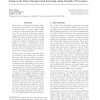Free Online Productivity Tools
i2Speak
i2Symbol
i2OCR
iTex2Img
iWeb2Print
iWeb2Shot
i2Type
iPdf2Split
iPdf2Merge
i2Bopomofo
i2Arabic
i2Style
i2Image
i2PDF
iLatex2Rtf
Sci2ools
ICML
2009
IEEE
2009
IEEE
Large-scale deep unsupervised learning using graphics processors
The promise of unsupervised learning methods lies in their potential to use vast amounts of unlabeled data to learn complex, highly nonlinear models with millions of free parameters. We consider two well-known unsupervised learning models, deep belief networks (DBNs) and sparse coding, that have recently been applied to a flurry of machine learning applications (Hinton & Salakhutdinov, 2006; Raina et al., 2007). Unfortunately, current learning algorithms for both models are too slow for large-scale applications, forcing researchers to focus on smaller-scale models, or to use fewer training examples. In this paper, we suggest massively parallel methods to help resolve these problems. We argue that modern graphics processors far surpass the computational capabilities of multicore CPUs, and have the potential to revolutionize the applicability of deep unsupervised learning methods. We develop general principles for massively parallelizing unsupervised learning tasks using graphics pr...
Deep Unsupervised Learning | ICML 2009 | Machine Learning | Unsupervised Learning Methods | Unsupervised Learning Models |
| Added | 17 Nov 2009 |
| Updated | 17 Nov 2009 |
| Type | Conference |
| Year | 2009 |
| Where | ICML |
| Authors | Rajat Raina, Anand Madhavan, Andrew Y. Ng |
Comments (0)

